Blockchain Technology in E-commerce: Case Study for Expansion
VerifiedAdded on 2020/05/16
|11
|3476
|208
Report
AI Summary
This report examines the application of blockchain technology within the e-commerce sector, focusing on its potential to enhance security, financial transactions, and supply chain management. The study begins by defining blockchain technology and outlining its latest developments. It then explores various applications, including its current uses in the banking and finance industries and its potential in the supermarket and hospitality sectors. The report selects three key applications relevant to a case study organization, offering recommendations for implementation and considering ethical, social, and legal implications. The report emphasizes the technology's role in securing confidential data, enabling robust financial transactions, and providing cost-effective solutions, aiming to guide the case study organization in expanding its e-commerce capabilities and addressing technological challenges. The report concludes by summarizing the benefits of blockchain in e-commerce.
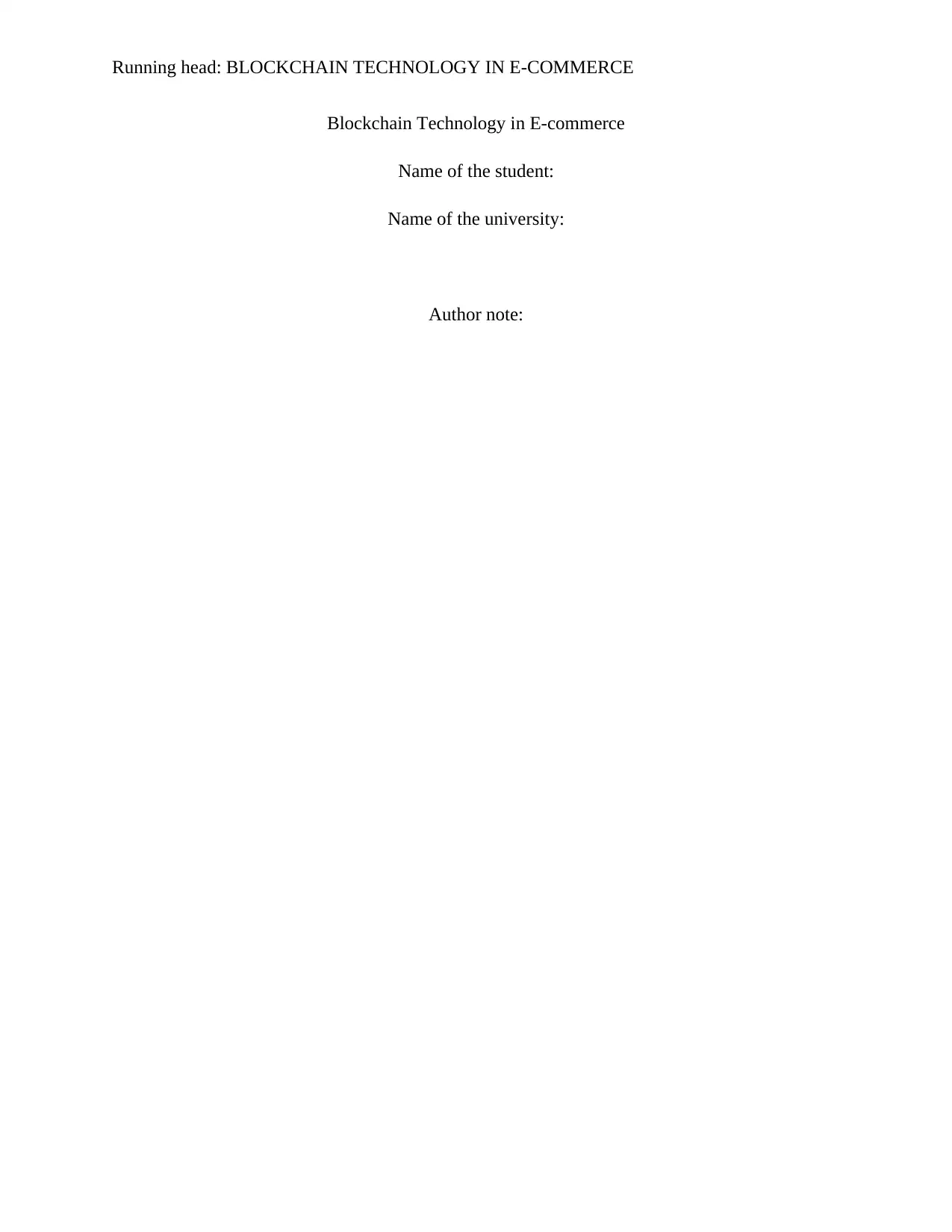
Running head: BLOCKCHAIN TECHNOLOGY IN E-COMMERCE
Blockchain Technology in E-commerce
Name of the student:
Name of the university:
Author note:
Blockchain Technology in E-commerce
Name of the student:
Name of the university:
Author note:
Paraphrase This Document
Need a fresh take? Get an instant paraphrase of this document with our AI Paraphraser
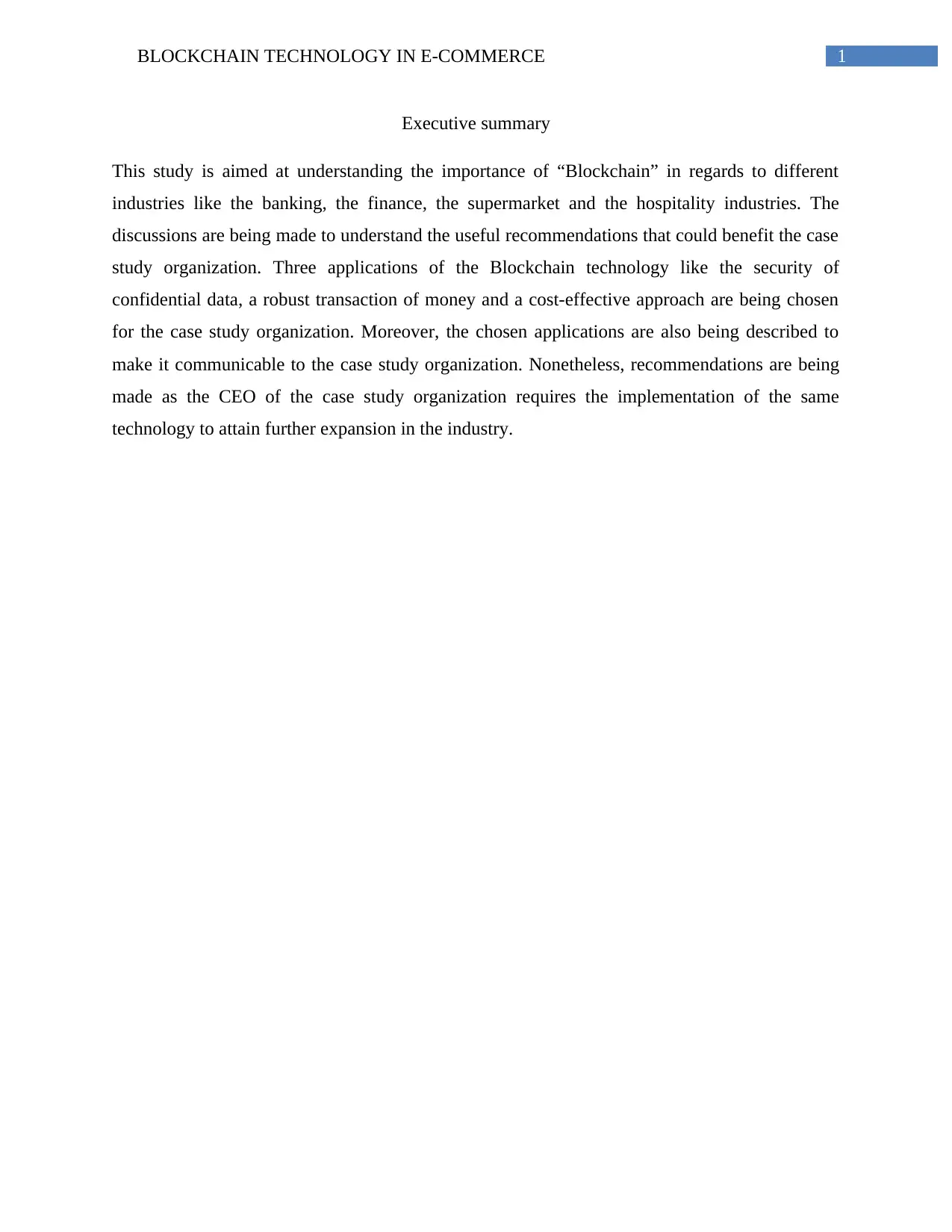
1BLOCKCHAIN TECHNOLOGY IN E-COMMERCE
Executive summary
This study is aimed at understanding the importance of “Blockchain” in regards to different
industries like the banking, the finance, the supermarket and the hospitality industries. The
discussions are being made to understand the useful recommendations that could benefit the case
study organization. Three applications of the Blockchain technology like the security of
confidential data, a robust transaction of money and a cost-effective approach are being chosen
for the case study organization. Moreover, the chosen applications are also being described to
make it communicable to the case study organization. Nonetheless, recommendations are being
made as the CEO of the case study organization requires the implementation of the same
technology to attain further expansion in the industry.
Executive summary
This study is aimed at understanding the importance of “Blockchain” in regards to different
industries like the banking, the finance, the supermarket and the hospitality industries. The
discussions are being made to understand the useful recommendations that could benefit the case
study organization. Three applications of the Blockchain technology like the security of
confidential data, a robust transaction of money and a cost-effective approach are being chosen
for the case study organization. Moreover, the chosen applications are also being described to
make it communicable to the case study organization. Nonetheless, recommendations are being
made as the CEO of the case study organization requires the implementation of the same
technology to attain further expansion in the industry.
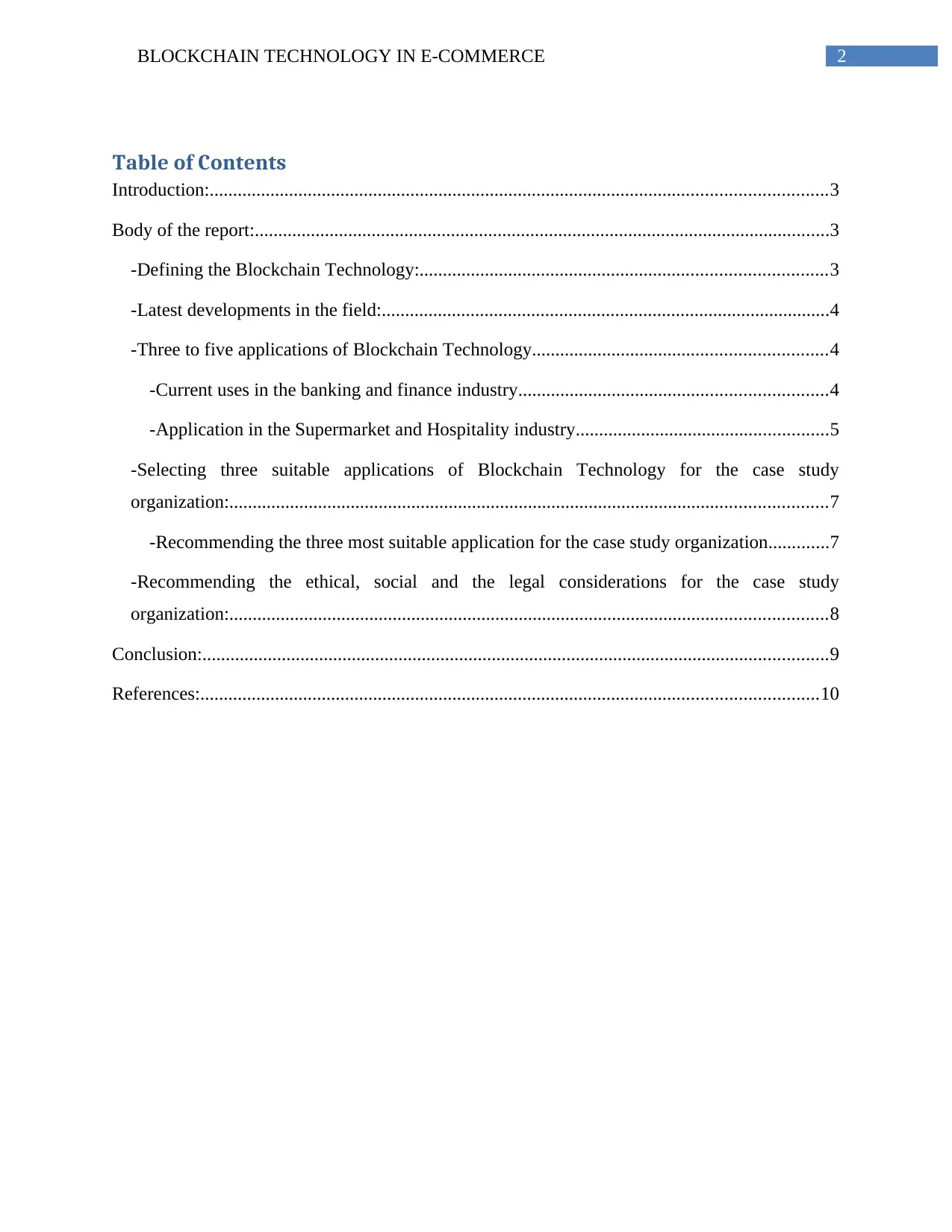
2BLOCKCHAIN TECHNOLOGY IN E-COMMERCE
Table of Contents
Introduction:....................................................................................................................................3
Body of the report:...........................................................................................................................3
-Defining the Blockchain Technology:.......................................................................................3
-Latest developments in the field:................................................................................................4
-Three to five applications of Blockchain Technology...............................................................4
-Current uses in the banking and finance industry..................................................................4
-Application in the Supermarket and Hospitality industry......................................................5
-Selecting three suitable applications of Blockchain Technology for the case study
organization:................................................................................................................................7
-Recommending the three most suitable application for the case study organization.............7
-Recommending the ethical, social and the legal considerations for the case study
organization:................................................................................................................................8
Conclusion:......................................................................................................................................9
References:....................................................................................................................................10
Table of Contents
Introduction:....................................................................................................................................3
Body of the report:...........................................................................................................................3
-Defining the Blockchain Technology:.......................................................................................3
-Latest developments in the field:................................................................................................4
-Three to five applications of Blockchain Technology...............................................................4
-Current uses in the banking and finance industry..................................................................4
-Application in the Supermarket and Hospitality industry......................................................5
-Selecting three suitable applications of Blockchain Technology for the case study
organization:................................................................................................................................7
-Recommending the three most suitable application for the case study organization.............7
-Recommending the ethical, social and the legal considerations for the case study
organization:................................................................................................................................8
Conclusion:......................................................................................................................................9
References:....................................................................................................................................10
⊘ This is a preview!⊘
Do you want full access?
Subscribe today to unlock all pages.

Trusted by 1+ million students worldwide

3BLOCKCHAIN TECHNOLOGY IN E-COMMERCE
Introduction:
The use of e-commerce had made things easier in terms of business transactions like
selling and purchasing of goods, making transactions over the internet and others. It has
narrowed down the distances between the business and the customers. Money transaction was
never that much easier as it happened after usage of the e-commerce platform. However, the
benefits had got accompanied with the several disadvantages as well. Few of the most common
disadvantages have been an insecure transaction of money & business and a fear to lose the
confidential data (Fang et al., 2014). The task had become easier; however, the security had
become relatively challenging. The Blockchain Technology in this regard is being considered as
the most disruptive inventions in the last few decades in terms of technology. It is also known as
the distributed ledger technology. The technology is believed to be safer as it operates in peer-to-
peer network mode, which means that only those will be allowed in the transactions that are the
identified faces for the system (Crosby et al., 2016).
This particular paper is aimed at understanding or finding the three most useful
application of the Blockchain technology as the case study organization has so far struggled in
regards to technological advancement. The organization that was established around 10 years
back in New South Wales (NSW) has its retail branches in some other parts of Australia like the
Sydney. The CEO of the company is aimed at expanding the business to a wider network at the
national level. However, the CEO is worried about the technology related glitches that have
made things challenging in the past. The CEO of the company does not want to repeat the same
mistake, which is why the CEO had thought to implement the Blockchain Technology to
enhance its e-commerce superiority.
Body of the report:
-Defining the Blockchain Technology:
Blockchain can be defined as a public electronic ledger through which information can be
shared and different transactions can be made in between the users that have been authorized for
the system (Dennis & Owenson, 2016). The system has few most important things, which had
never been possible in the decades. First and foremost, the transactions made using the
Introduction:
The use of e-commerce had made things easier in terms of business transactions like
selling and purchasing of goods, making transactions over the internet and others. It has
narrowed down the distances between the business and the customers. Money transaction was
never that much easier as it happened after usage of the e-commerce platform. However, the
benefits had got accompanied with the several disadvantages as well. Few of the most common
disadvantages have been an insecure transaction of money & business and a fear to lose the
confidential data (Fang et al., 2014). The task had become easier; however, the security had
become relatively challenging. The Blockchain Technology in this regard is being considered as
the most disruptive inventions in the last few decades in terms of technology. It is also known as
the distributed ledger technology. The technology is believed to be safer as it operates in peer-to-
peer network mode, which means that only those will be allowed in the transactions that are the
identified faces for the system (Crosby et al., 2016).
This particular paper is aimed at understanding or finding the three most useful
application of the Blockchain technology as the case study organization has so far struggled in
regards to technological advancement. The organization that was established around 10 years
back in New South Wales (NSW) has its retail branches in some other parts of Australia like the
Sydney. The CEO of the company is aimed at expanding the business to a wider network at the
national level. However, the CEO is worried about the technology related glitches that have
made things challenging in the past. The CEO of the company does not want to repeat the same
mistake, which is why the CEO had thought to implement the Blockchain Technology to
enhance its e-commerce superiority.
Body of the report:
-Defining the Blockchain Technology:
Blockchain can be defined as a public electronic ledger through which information can be
shared and different transactions can be made in between the users that have been authorized for
the system (Dennis & Owenson, 2016). The system has few most important things, which had
never been possible in the decades. First and foremost, the transactions made using the
Paraphrase This Document
Need a fresh take? Get an instant paraphrase of this document with our AI Paraphraser
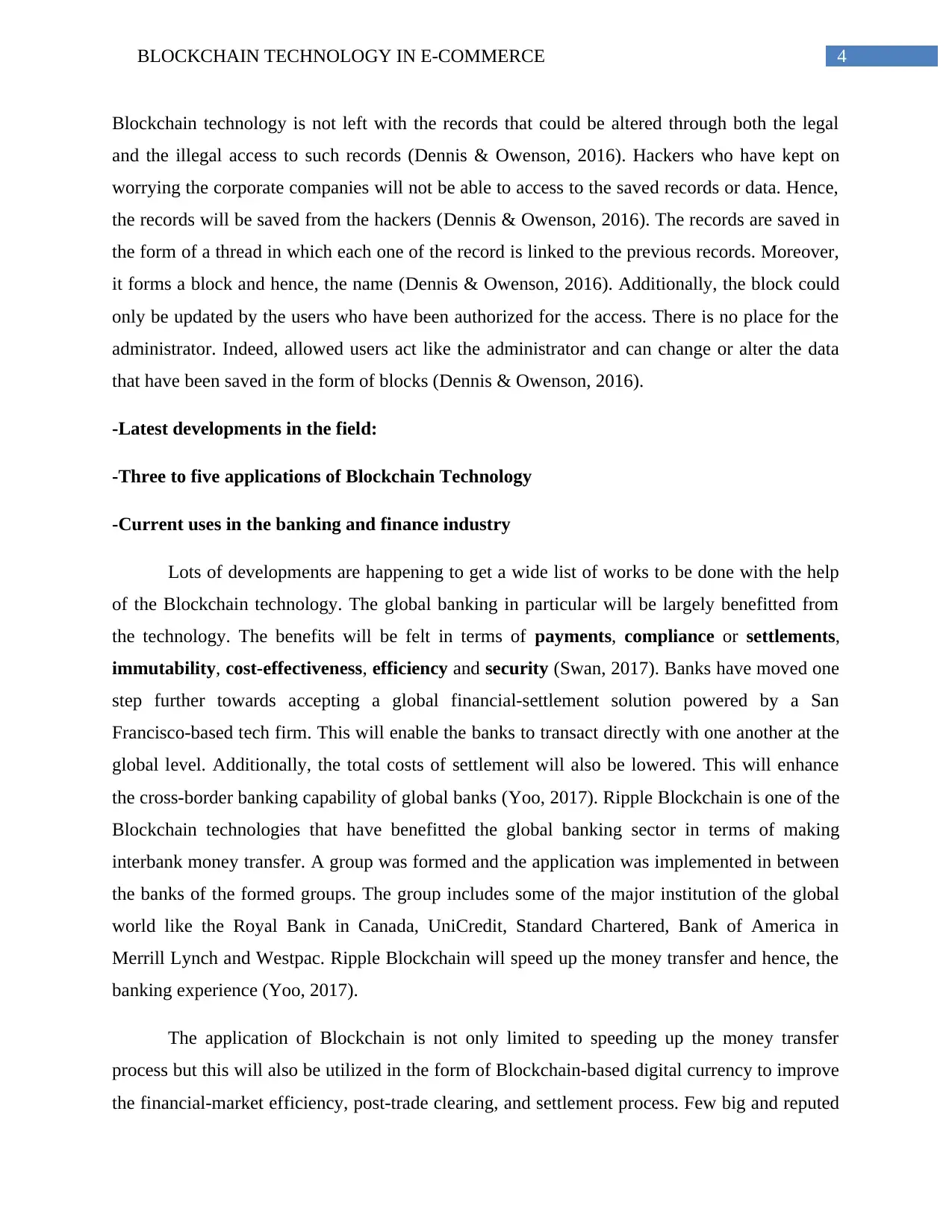
4BLOCKCHAIN TECHNOLOGY IN E-COMMERCE
Blockchain technology is not left with the records that could be altered through both the legal
and the illegal access to such records (Dennis & Owenson, 2016). Hackers who have kept on
worrying the corporate companies will not be able to access to the saved records or data. Hence,
the records will be saved from the hackers (Dennis & Owenson, 2016). The records are saved in
the form of a thread in which each one of the record is linked to the previous records. Moreover,
it forms a block and hence, the name (Dennis & Owenson, 2016). Additionally, the block could
only be updated by the users who have been authorized for the access. There is no place for the
administrator. Indeed, allowed users act like the administrator and can change or alter the data
that have been saved in the form of blocks (Dennis & Owenson, 2016).
-Latest developments in the field:
-Three to five applications of Blockchain Technology
-Current uses in the banking and finance industry
Lots of developments are happening to get a wide list of works to be done with the help
of the Blockchain technology. The global banking in particular will be largely benefitted from
the technology. The benefits will be felt in terms of payments, compliance or settlements,
immutability, cost-effectiveness, efficiency and security (Swan, 2017). Banks have moved one
step further towards accepting a global financial-settlement solution powered by a San
Francisco-based tech firm. This will enable the banks to transact directly with one another at the
global level. Additionally, the total costs of settlement will also be lowered. This will enhance
the cross-border banking capability of global banks (Yoo, 2017). Ripple Blockchain is one of the
Blockchain technologies that have benefitted the global banking sector in terms of making
interbank money transfer. A group was formed and the application was implemented in between
the banks of the formed groups. The group includes some of the major institution of the global
world like the Royal Bank in Canada, UniCredit, Standard Chartered, Bank of America in
Merrill Lynch and Westpac. Ripple Blockchain will speed up the money transfer and hence, the
banking experience (Yoo, 2017).
The application of Blockchain is not only limited to speeding up the money transfer
process but this will also be utilized in the form of Blockchain-based digital currency to improve
the financial-market efficiency, post-trade clearing, and settlement process. Few big and reputed
Blockchain technology is not left with the records that could be altered through both the legal
and the illegal access to such records (Dennis & Owenson, 2016). Hackers who have kept on
worrying the corporate companies will not be able to access to the saved records or data. Hence,
the records will be saved from the hackers (Dennis & Owenson, 2016). The records are saved in
the form of a thread in which each one of the record is linked to the previous records. Moreover,
it forms a block and hence, the name (Dennis & Owenson, 2016). Additionally, the block could
only be updated by the users who have been authorized for the access. There is no place for the
administrator. Indeed, allowed users act like the administrator and can change or alter the data
that have been saved in the form of blocks (Dennis & Owenson, 2016).
-Latest developments in the field:
-Three to five applications of Blockchain Technology
-Current uses in the banking and finance industry
Lots of developments are happening to get a wide list of works to be done with the help
of the Blockchain technology. The global banking in particular will be largely benefitted from
the technology. The benefits will be felt in terms of payments, compliance or settlements,
immutability, cost-effectiveness, efficiency and security (Swan, 2017). Banks have moved one
step further towards accepting a global financial-settlement solution powered by a San
Francisco-based tech firm. This will enable the banks to transact directly with one another at the
global level. Additionally, the total costs of settlement will also be lowered. This will enhance
the cross-border banking capability of global banks (Yoo, 2017). Ripple Blockchain is one of the
Blockchain technologies that have benefitted the global banking sector in terms of making
interbank money transfer. A group was formed and the application was implemented in between
the banks of the formed groups. The group includes some of the major institution of the global
world like the Royal Bank in Canada, UniCredit, Standard Chartered, Bank of America in
Merrill Lynch and Westpac. Ripple Blockchain will speed up the money transfer and hence, the
banking experience (Yoo, 2017).
The application of Blockchain is not only limited to speeding up the money transfer
process but this will also be utilized in the form of Blockchain-based digital currency to improve
the financial-market efficiency, post-trade clearing, and settlement process. Few big and reputed
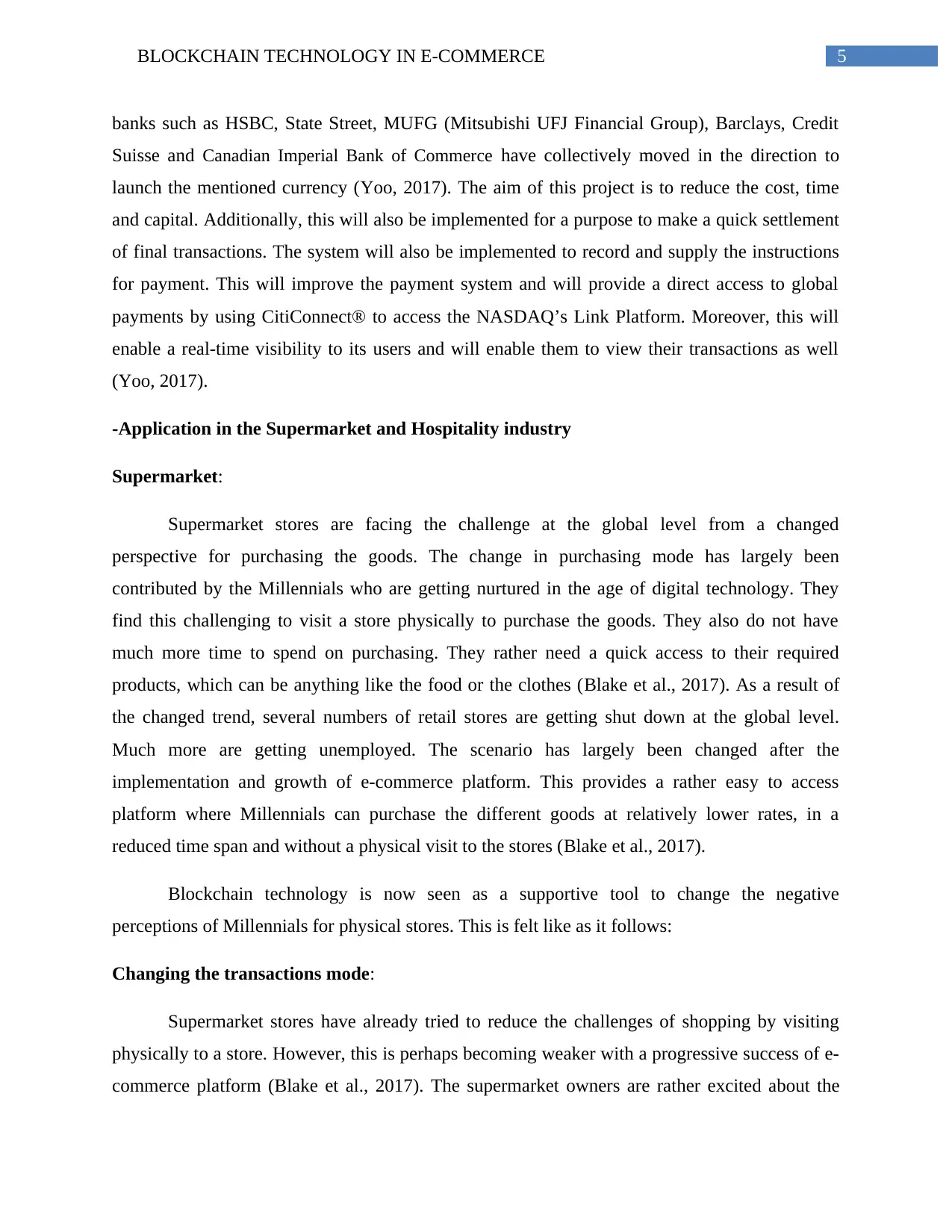
5BLOCKCHAIN TECHNOLOGY IN E-COMMERCE
banks such as HSBC, State Street, MUFG (Mitsubishi UFJ Financial Group), Barclays, Credit
Suisse and Canadian Imperial Bank of Commerce have collectively moved in the direction to
launch the mentioned currency (Yoo, 2017). The aim of this project is to reduce the cost, time
and capital. Additionally, this will also be implemented for a purpose to make a quick settlement
of final transactions. The system will also be implemented to record and supply the instructions
for payment. This will improve the payment system and will provide a direct access to global
payments by using CitiConnect® to access the NASDAQ’s Link Platform. Moreover, this will
enable a real-time visibility to its users and will enable them to view their transactions as well
(Yoo, 2017).
-Application in the Supermarket and Hospitality industry
Supermarket:
Supermarket stores are facing the challenge at the global level from a changed
perspective for purchasing the goods. The change in purchasing mode has largely been
contributed by the Millennials who are getting nurtured in the age of digital technology. They
find this challenging to visit a store physically to purchase the goods. They also do not have
much more time to spend on purchasing. They rather need a quick access to their required
products, which can be anything like the food or the clothes (Blake et al., 2017). As a result of
the changed trend, several numbers of retail stores are getting shut down at the global level.
Much more are getting unemployed. The scenario has largely been changed after the
implementation and growth of e-commerce platform. This provides a rather easy to access
platform where Millennials can purchase the different goods at relatively lower rates, in a
reduced time span and without a physical visit to the stores (Blake et al., 2017).
Blockchain technology is now seen as a supportive tool to change the negative
perceptions of Millennials for physical stores. This is felt like as it follows:
Changing the transactions mode:
Supermarket stores have already tried to reduce the challenges of shopping by visiting
physically to a store. However, this is perhaps becoming weaker with a progressive success of e-
commerce platform (Blake et al., 2017). The supermarket owners are rather excited about the
banks such as HSBC, State Street, MUFG (Mitsubishi UFJ Financial Group), Barclays, Credit
Suisse and Canadian Imperial Bank of Commerce have collectively moved in the direction to
launch the mentioned currency (Yoo, 2017). The aim of this project is to reduce the cost, time
and capital. Additionally, this will also be implemented for a purpose to make a quick settlement
of final transactions. The system will also be implemented to record and supply the instructions
for payment. This will improve the payment system and will provide a direct access to global
payments by using CitiConnect® to access the NASDAQ’s Link Platform. Moreover, this will
enable a real-time visibility to its users and will enable them to view their transactions as well
(Yoo, 2017).
-Application in the Supermarket and Hospitality industry
Supermarket:
Supermarket stores are facing the challenge at the global level from a changed
perspective for purchasing the goods. The change in purchasing mode has largely been
contributed by the Millennials who are getting nurtured in the age of digital technology. They
find this challenging to visit a store physically to purchase the goods. They also do not have
much more time to spend on purchasing. They rather need a quick access to their required
products, which can be anything like the food or the clothes (Blake et al., 2017). As a result of
the changed trend, several numbers of retail stores are getting shut down at the global level.
Much more are getting unemployed. The scenario has largely been changed after the
implementation and growth of e-commerce platform. This provides a rather easy to access
platform where Millennials can purchase the different goods at relatively lower rates, in a
reduced time span and without a physical visit to the stores (Blake et al., 2017).
Blockchain technology is now seen as a supportive tool to change the negative
perceptions of Millennials for physical stores. This is felt like as it follows:
Changing the transactions mode:
Supermarket stores have already tried to reduce the challenges of shopping by visiting
physically to a store. However, this is perhaps becoming weaker with a progressive success of e-
commerce platform (Blake et al., 2017). The supermarket owners are rather excited about the
⊘ This is a preview!⊘
Do you want full access?
Subscribe today to unlock all pages.

Trusted by 1+ million students worldwide
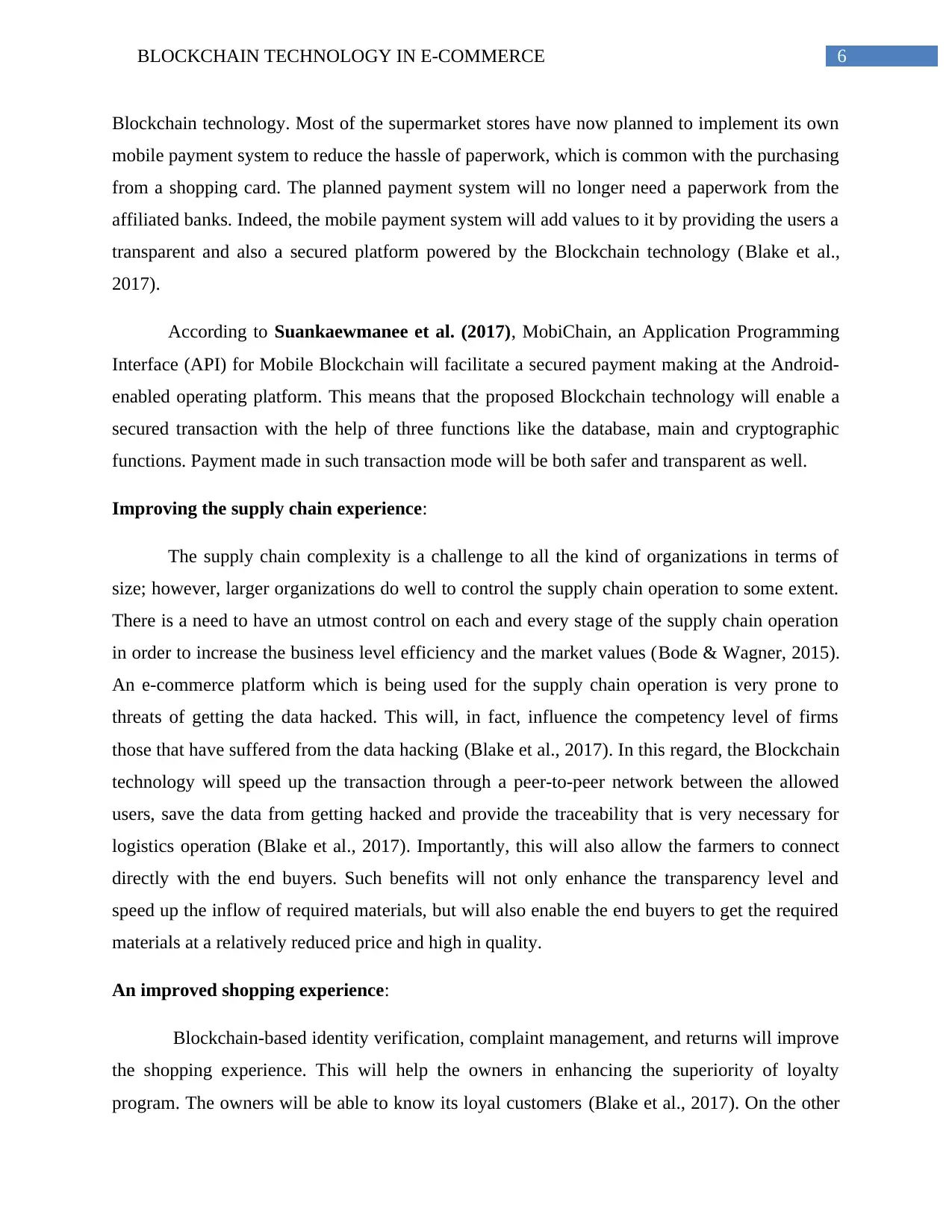
6BLOCKCHAIN TECHNOLOGY IN E-COMMERCE
Blockchain technology. Most of the supermarket stores have now planned to implement its own
mobile payment system to reduce the hassle of paperwork, which is common with the purchasing
from a shopping card. The planned payment system will no longer need a paperwork from the
affiliated banks. Indeed, the mobile payment system will add values to it by providing the users a
transparent and also a secured platform powered by the Blockchain technology (Blake et al.,
2017).
According to Suankaewmanee et al. (2017), MobiChain, an Application Programming
Interface (API) for Mobile Blockchain will facilitate a secured payment making at the Android-
enabled operating platform. This means that the proposed Blockchain technology will enable a
secured transaction with the help of three functions like the database, main and cryptographic
functions. Payment made in such transaction mode will be both safer and transparent as well.
Improving the supply chain experience:
The supply chain complexity is a challenge to all the kind of organizations in terms of
size; however, larger organizations do well to control the supply chain operation to some extent.
There is a need to have an utmost control on each and every stage of the supply chain operation
in order to increase the business level efficiency and the market values (Bode & Wagner, 2015).
An e-commerce platform which is being used for the supply chain operation is very prone to
threats of getting the data hacked. This will, in fact, influence the competency level of firms
those that have suffered from the data hacking (Blake et al., 2017). In this regard, the Blockchain
technology will speed up the transaction through a peer-to-peer network between the allowed
users, save the data from getting hacked and provide the traceability that is very necessary for
logistics operation (Blake et al., 2017). Importantly, this will also allow the farmers to connect
directly with the end buyers. Such benefits will not only enhance the transparency level and
speed up the inflow of required materials, but will also enable the end buyers to get the required
materials at a relatively reduced price and high in quality.
An improved shopping experience:
Blockchain-based identity verification, complaint management, and returns will improve
the shopping experience. This will help the owners in enhancing the superiority of loyalty
program. The owners will be able to know its loyal customers (Blake et al., 2017). On the other
Blockchain technology. Most of the supermarket stores have now planned to implement its own
mobile payment system to reduce the hassle of paperwork, which is common with the purchasing
from a shopping card. The planned payment system will no longer need a paperwork from the
affiliated banks. Indeed, the mobile payment system will add values to it by providing the users a
transparent and also a secured platform powered by the Blockchain technology (Blake et al.,
2017).
According to Suankaewmanee et al. (2017), MobiChain, an Application Programming
Interface (API) for Mobile Blockchain will facilitate a secured payment making at the Android-
enabled operating platform. This means that the proposed Blockchain technology will enable a
secured transaction with the help of three functions like the database, main and cryptographic
functions. Payment made in such transaction mode will be both safer and transparent as well.
Improving the supply chain experience:
The supply chain complexity is a challenge to all the kind of organizations in terms of
size; however, larger organizations do well to control the supply chain operation to some extent.
There is a need to have an utmost control on each and every stage of the supply chain operation
in order to increase the business level efficiency and the market values (Bode & Wagner, 2015).
An e-commerce platform which is being used for the supply chain operation is very prone to
threats of getting the data hacked. This will, in fact, influence the competency level of firms
those that have suffered from the data hacking (Blake et al., 2017). In this regard, the Blockchain
technology will speed up the transaction through a peer-to-peer network between the allowed
users, save the data from getting hacked and provide the traceability that is very necessary for
logistics operation (Blake et al., 2017). Importantly, this will also allow the farmers to connect
directly with the end buyers. Such benefits will not only enhance the transparency level and
speed up the inflow of required materials, but will also enable the end buyers to get the required
materials at a relatively reduced price and high in quality.
An improved shopping experience:
Blockchain-based identity verification, complaint management, and returns will improve
the shopping experience. This will help the owners in enhancing the superiority of loyalty
program. The owners will be able to know its loyal customers (Blake et al., 2017). On the other
Paraphrase This Document
Need a fresh take? Get an instant paraphrase of this document with our AI Paraphraser
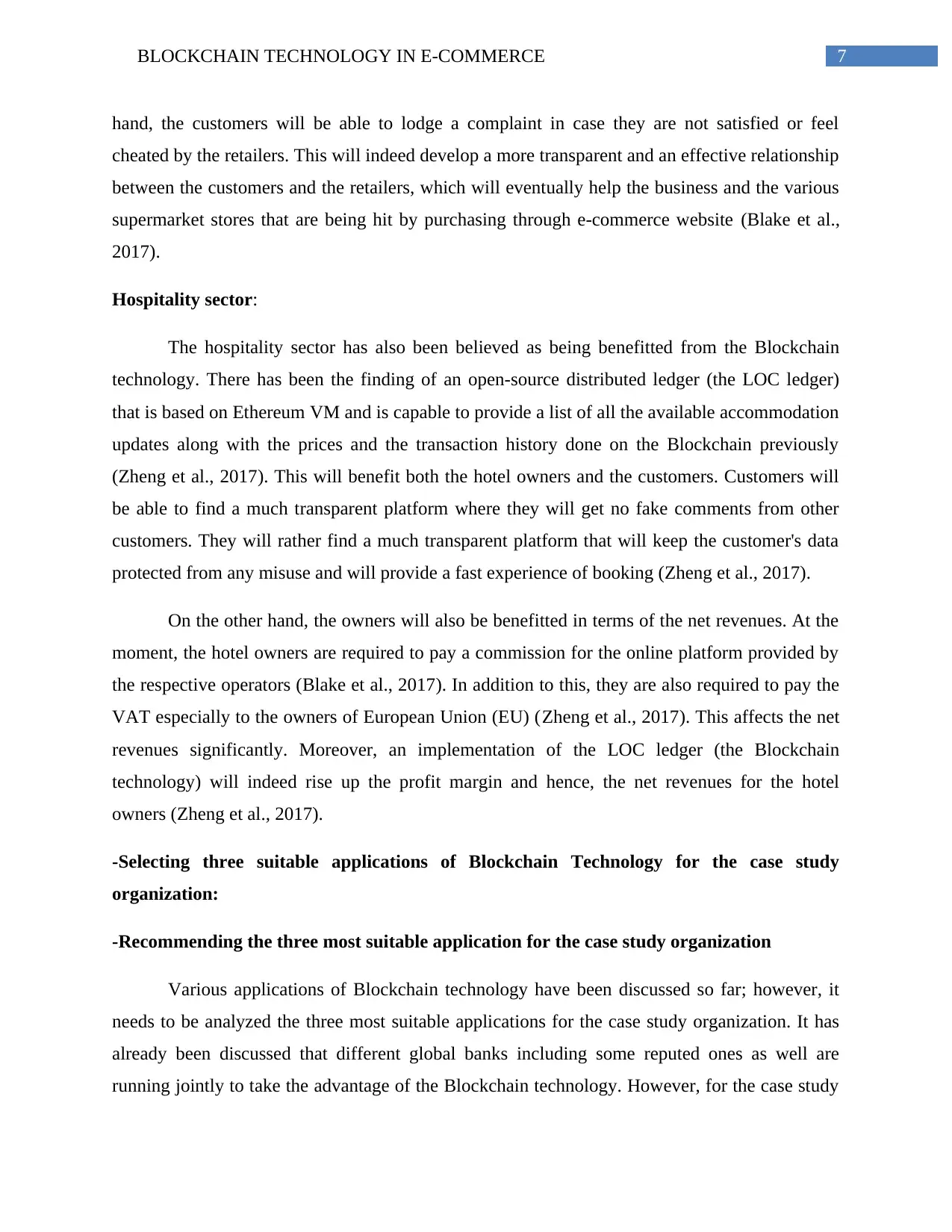
7BLOCKCHAIN TECHNOLOGY IN E-COMMERCE
hand, the customers will be able to lodge a complaint in case they are not satisfied or feel
cheated by the retailers. This will indeed develop a more transparent and an effective relationship
between the customers and the retailers, which will eventually help the business and the various
supermarket stores that are being hit by purchasing through e-commerce website (Blake et al.,
2017).
Hospitality sector:
The hospitality sector has also been believed as being benefitted from the Blockchain
technology. There has been the finding of an open-source distributed ledger (the LOC ledger)
that is based on Ethereum VM and is capable to provide a list of all the available accommodation
updates along with the prices and the transaction history done on the Blockchain previously
(Zheng et al., 2017). This will benefit both the hotel owners and the customers. Customers will
be able to find a much transparent platform where they will get no fake comments from other
customers. They will rather find a much transparent platform that will keep the customer's data
protected from any misuse and will provide a fast experience of booking (Zheng et al., 2017).
On the other hand, the owners will also be benefitted in terms of the net revenues. At the
moment, the hotel owners are required to pay a commission for the online platform provided by
the respective operators (Blake et al., 2017). In addition to this, they are also required to pay the
VAT especially to the owners of European Union (EU) (Zheng et al., 2017). This affects the net
revenues significantly. Moreover, an implementation of the LOC ledger (the Blockchain
technology) will indeed rise up the profit margin and hence, the net revenues for the hotel
owners (Zheng et al., 2017).
-Selecting three suitable applications of Blockchain Technology for the case study
organization:
-Recommending the three most suitable application for the case study organization
Various applications of Blockchain technology have been discussed so far; however, it
needs to be analyzed the three most suitable applications for the case study organization. It has
already been discussed that different global banks including some reputed ones as well are
running jointly to take the advantage of the Blockchain technology. However, for the case study
hand, the customers will be able to lodge a complaint in case they are not satisfied or feel
cheated by the retailers. This will indeed develop a more transparent and an effective relationship
between the customers and the retailers, which will eventually help the business and the various
supermarket stores that are being hit by purchasing through e-commerce website (Blake et al.,
2017).
Hospitality sector:
The hospitality sector has also been believed as being benefitted from the Blockchain
technology. There has been the finding of an open-source distributed ledger (the LOC ledger)
that is based on Ethereum VM and is capable to provide a list of all the available accommodation
updates along with the prices and the transaction history done on the Blockchain previously
(Zheng et al., 2017). This will benefit both the hotel owners and the customers. Customers will
be able to find a much transparent platform where they will get no fake comments from other
customers. They will rather find a much transparent platform that will keep the customer's data
protected from any misuse and will provide a fast experience of booking (Zheng et al., 2017).
On the other hand, the owners will also be benefitted in terms of the net revenues. At the
moment, the hotel owners are required to pay a commission for the online platform provided by
the respective operators (Blake et al., 2017). In addition to this, they are also required to pay the
VAT especially to the owners of European Union (EU) (Zheng et al., 2017). This affects the net
revenues significantly. Moreover, an implementation of the LOC ledger (the Blockchain
technology) will indeed rise up the profit margin and hence, the net revenues for the hotel
owners (Zheng et al., 2017).
-Selecting three suitable applications of Blockchain Technology for the case study
organization:
-Recommending the three most suitable application for the case study organization
Various applications of Blockchain technology have been discussed so far; however, it
needs to be analyzed the three most suitable applications for the case study organization. It has
already been discussed that different global banks including some reputed ones as well are
running jointly to take the advantage of the Blockchain technology. However, for the case study
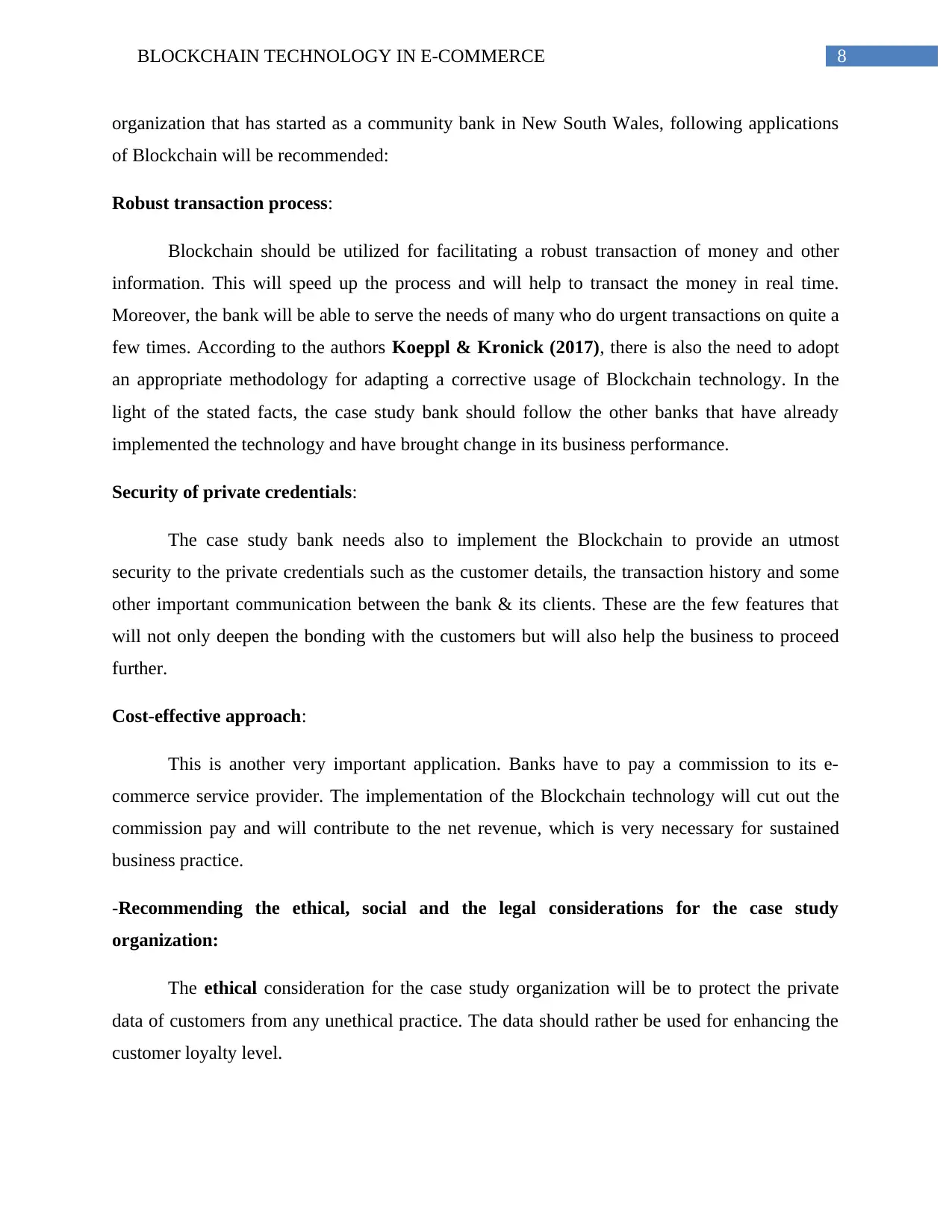
8BLOCKCHAIN TECHNOLOGY IN E-COMMERCE
organization that has started as a community bank in New South Wales, following applications
of Blockchain will be recommended:
Robust transaction process:
Blockchain should be utilized for facilitating a robust transaction of money and other
information. This will speed up the process and will help to transact the money in real time.
Moreover, the bank will be able to serve the needs of many who do urgent transactions on quite a
few times. According to the authors Koeppl & Kronick (2017), there is also the need to adopt
an appropriate methodology for adapting a corrective usage of Blockchain technology. In the
light of the stated facts, the case study bank should follow the other banks that have already
implemented the technology and have brought change in its business performance.
Security of private credentials:
The case study bank needs also to implement the Blockchain to provide an utmost
security to the private credentials such as the customer details, the transaction history and some
other important communication between the bank & its clients. These are the few features that
will not only deepen the bonding with the customers but will also help the business to proceed
further.
Cost-effective approach:
This is another very important application. Banks have to pay a commission to its e-
commerce service provider. The implementation of the Blockchain technology will cut out the
commission pay and will contribute to the net revenue, which is very necessary for sustained
business practice.
-Recommending the ethical, social and the legal considerations for the case study
organization:
The ethical consideration for the case study organization will be to protect the private
data of customers from any unethical practice. The data should rather be used for enhancing the
customer loyalty level.
organization that has started as a community bank in New South Wales, following applications
of Blockchain will be recommended:
Robust transaction process:
Blockchain should be utilized for facilitating a robust transaction of money and other
information. This will speed up the process and will help to transact the money in real time.
Moreover, the bank will be able to serve the needs of many who do urgent transactions on quite a
few times. According to the authors Koeppl & Kronick (2017), there is also the need to adopt
an appropriate methodology for adapting a corrective usage of Blockchain technology. In the
light of the stated facts, the case study bank should follow the other banks that have already
implemented the technology and have brought change in its business performance.
Security of private credentials:
The case study bank needs also to implement the Blockchain to provide an utmost
security to the private credentials such as the customer details, the transaction history and some
other important communication between the bank & its clients. These are the few features that
will not only deepen the bonding with the customers but will also help the business to proceed
further.
Cost-effective approach:
This is another very important application. Banks have to pay a commission to its e-
commerce service provider. The implementation of the Blockchain technology will cut out the
commission pay and will contribute to the net revenue, which is very necessary for sustained
business practice.
-Recommending the ethical, social and the legal considerations for the case study
organization:
The ethical consideration for the case study organization will be to protect the private
data of customers from any unethical practice. The data should rather be used for enhancing the
customer loyalty level.
⊘ This is a preview!⊘
Do you want full access?
Subscribe today to unlock all pages.

Trusted by 1+ million students worldwide
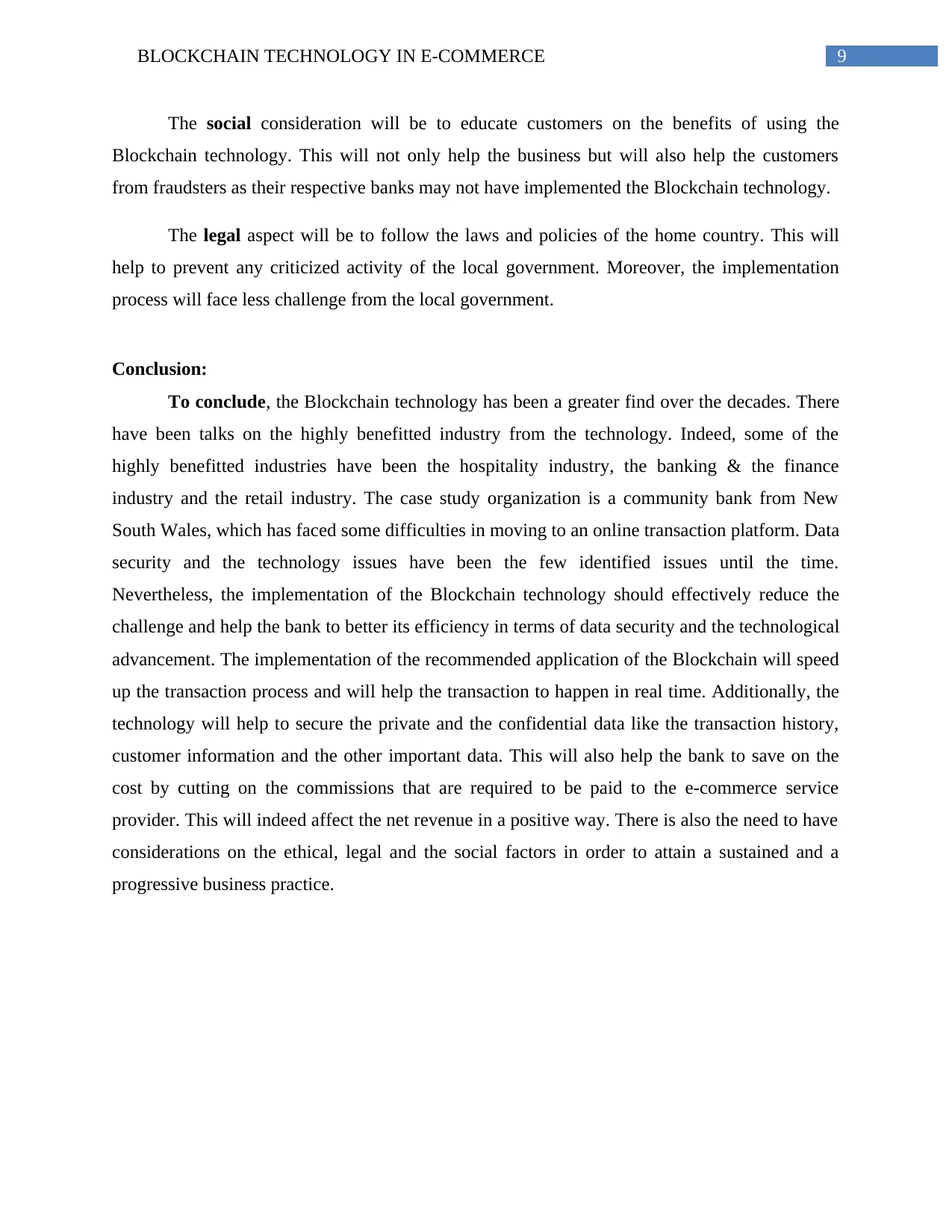
9BLOCKCHAIN TECHNOLOGY IN E-COMMERCE
The social consideration will be to educate customers on the benefits of using the
Blockchain technology. This will not only help the business but will also help the customers
from fraudsters as their respective banks may not have implemented the Blockchain technology.
The legal aspect will be to follow the laws and policies of the home country. This will
help to prevent any criticized activity of the local government. Moreover, the implementation
process will face less challenge from the local government.
Conclusion:
To conclude, the Blockchain technology has been a greater find over the decades. There
have been talks on the highly benefitted industry from the technology. Indeed, some of the
highly benefitted industries have been the hospitality industry, the banking & the finance
industry and the retail industry. The case study organization is a community bank from New
South Wales, which has faced some difficulties in moving to an online transaction platform. Data
security and the technology issues have been the few identified issues until the time.
Nevertheless, the implementation of the Blockchain technology should effectively reduce the
challenge and help the bank to better its efficiency in terms of data security and the technological
advancement. The implementation of the recommended application of the Blockchain will speed
up the transaction process and will help the transaction to happen in real time. Additionally, the
technology will help to secure the private and the confidential data like the transaction history,
customer information and the other important data. This will also help the bank to save on the
cost by cutting on the commissions that are required to be paid to the e-commerce service
provider. This will indeed affect the net revenue in a positive way. There is also the need to have
considerations on the ethical, legal and the social factors in order to attain a sustained and a
progressive business practice.
The social consideration will be to educate customers on the benefits of using the
Blockchain technology. This will not only help the business but will also help the customers
from fraudsters as their respective banks may not have implemented the Blockchain technology.
The legal aspect will be to follow the laws and policies of the home country. This will
help to prevent any criticized activity of the local government. Moreover, the implementation
process will face less challenge from the local government.
Conclusion:
To conclude, the Blockchain technology has been a greater find over the decades. There
have been talks on the highly benefitted industry from the technology. Indeed, some of the
highly benefitted industries have been the hospitality industry, the banking & the finance
industry and the retail industry. The case study organization is a community bank from New
South Wales, which has faced some difficulties in moving to an online transaction platform. Data
security and the technology issues have been the few identified issues until the time.
Nevertheless, the implementation of the Blockchain technology should effectively reduce the
challenge and help the bank to better its efficiency in terms of data security and the technological
advancement. The implementation of the recommended application of the Blockchain will speed
up the transaction process and will help the transaction to happen in real time. Additionally, the
technology will help to secure the private and the confidential data like the transaction history,
customer information and the other important data. This will also help the bank to save on the
cost by cutting on the commissions that are required to be paid to the e-commerce service
provider. This will indeed affect the net revenue in a positive way. There is also the need to have
considerations on the ethical, legal and the social factors in order to attain a sustained and a
progressive business practice.
Paraphrase This Document
Need a fresh take? Get an instant paraphrase of this document with our AI Paraphraser
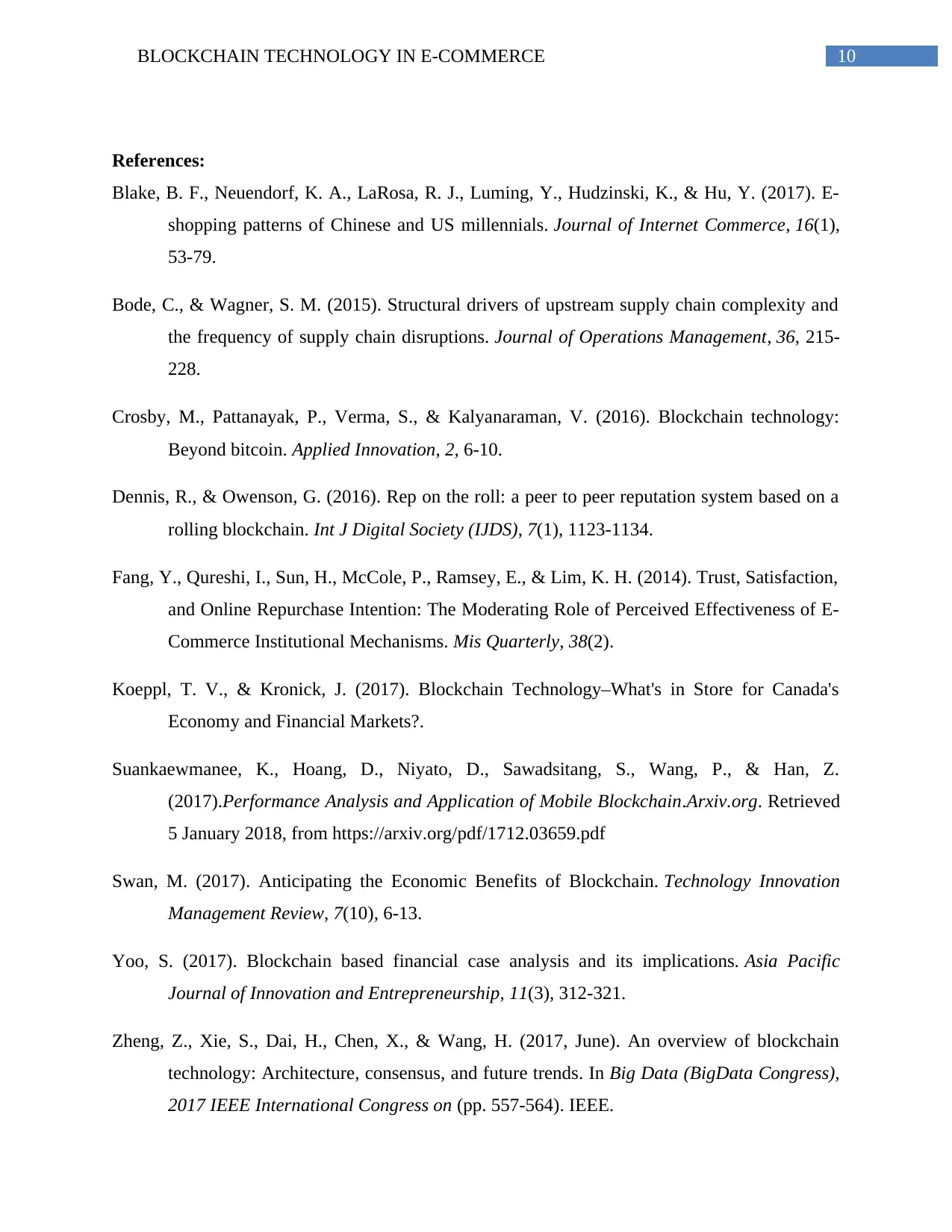
10BLOCKCHAIN TECHNOLOGY IN E-COMMERCE
References:
Blake, B. F., Neuendorf, K. A., LaRosa, R. J., Luming, Y., Hudzinski, K., & Hu, Y. (2017). E-
shopping patterns of Chinese and US millennials. Journal of Internet Commerce, 16(1),
53-79.
Bode, C., & Wagner, S. M. (2015). Structural drivers of upstream supply chain complexity and
the frequency of supply chain disruptions. Journal of Operations Management, 36, 215-
228.
Crosby, M., Pattanayak, P., Verma, S., & Kalyanaraman, V. (2016). Blockchain technology:
Beyond bitcoin. Applied Innovation, 2, 6-10.
Dennis, R., & Owenson, G. (2016). Rep on the roll: a peer to peer reputation system based on a
rolling blockchain. Int J Digital Society (IJDS), 7(1), 1123-1134.
Fang, Y., Qureshi, I., Sun, H., McCole, P., Ramsey, E., & Lim, K. H. (2014). Trust, Satisfaction,
and Online Repurchase Intention: The Moderating Role of Perceived Effectiveness of E-
Commerce Institutional Mechanisms. Mis Quarterly, 38(2).
Koeppl, T. V., & Kronick, J. (2017). Blockchain Technology–What's in Store for Canada's
Economy and Financial Markets?.
Suankaewmanee, K., Hoang, D., Niyato, D., Sawadsitang, S., Wang, P., & Han, Z.
(2017).Performance Analysis and Application of Mobile Blockchain.Arxiv.org. Retrieved
5 January 2018, from https://arxiv.org/pdf/1712.03659.pdf
Swan, M. (2017). Anticipating the Economic Benefits of Blockchain. Technology Innovation
Management Review, 7(10), 6-13.
Yoo, S. (2017). Blockchain based financial case analysis and its implications. Asia Pacific
Journal of Innovation and Entrepreneurship, 11(3), 312-321.
Zheng, Z., Xie, S., Dai, H., Chen, X., & Wang, H. (2017, June). An overview of blockchain
technology: Architecture, consensus, and future trends. In Big Data (BigData Congress),
2017 IEEE International Congress on (pp. 557-564). IEEE.
References:
Blake, B. F., Neuendorf, K. A., LaRosa, R. J., Luming, Y., Hudzinski, K., & Hu, Y. (2017). E-
shopping patterns of Chinese and US millennials. Journal of Internet Commerce, 16(1),
53-79.
Bode, C., & Wagner, S. M. (2015). Structural drivers of upstream supply chain complexity and
the frequency of supply chain disruptions. Journal of Operations Management, 36, 215-
228.
Crosby, M., Pattanayak, P., Verma, S., & Kalyanaraman, V. (2016). Blockchain technology:
Beyond bitcoin. Applied Innovation, 2, 6-10.
Dennis, R., & Owenson, G. (2016). Rep on the roll: a peer to peer reputation system based on a
rolling blockchain. Int J Digital Society (IJDS), 7(1), 1123-1134.
Fang, Y., Qureshi, I., Sun, H., McCole, P., Ramsey, E., & Lim, K. H. (2014). Trust, Satisfaction,
and Online Repurchase Intention: The Moderating Role of Perceived Effectiveness of E-
Commerce Institutional Mechanisms. Mis Quarterly, 38(2).
Koeppl, T. V., & Kronick, J. (2017). Blockchain Technology–What's in Store for Canada's
Economy and Financial Markets?.
Suankaewmanee, K., Hoang, D., Niyato, D., Sawadsitang, S., Wang, P., & Han, Z.
(2017).Performance Analysis and Application of Mobile Blockchain.Arxiv.org. Retrieved
5 January 2018, from https://arxiv.org/pdf/1712.03659.pdf
Swan, M. (2017). Anticipating the Economic Benefits of Blockchain. Technology Innovation
Management Review, 7(10), 6-13.
Yoo, S. (2017). Blockchain based financial case analysis and its implications. Asia Pacific
Journal of Innovation and Entrepreneurship, 11(3), 312-321.
Zheng, Z., Xie, S., Dai, H., Chen, X., & Wang, H. (2017, June). An overview of blockchain
technology: Architecture, consensus, and future trends. In Big Data (BigData Congress),
2017 IEEE International Congress on (pp. 557-564). IEEE.
1 out of 11
Related Documents
Your All-in-One AI-Powered Toolkit for Academic Success.
+13062052269
info@desklib.com
Available 24*7 on WhatsApp / Email
![[object Object]](/_next/static/media/star-bottom.7253800d.svg)
Unlock your academic potential
Copyright © 2020–2025 A2Z Services. All Rights Reserved. Developed and managed by ZUCOL.





